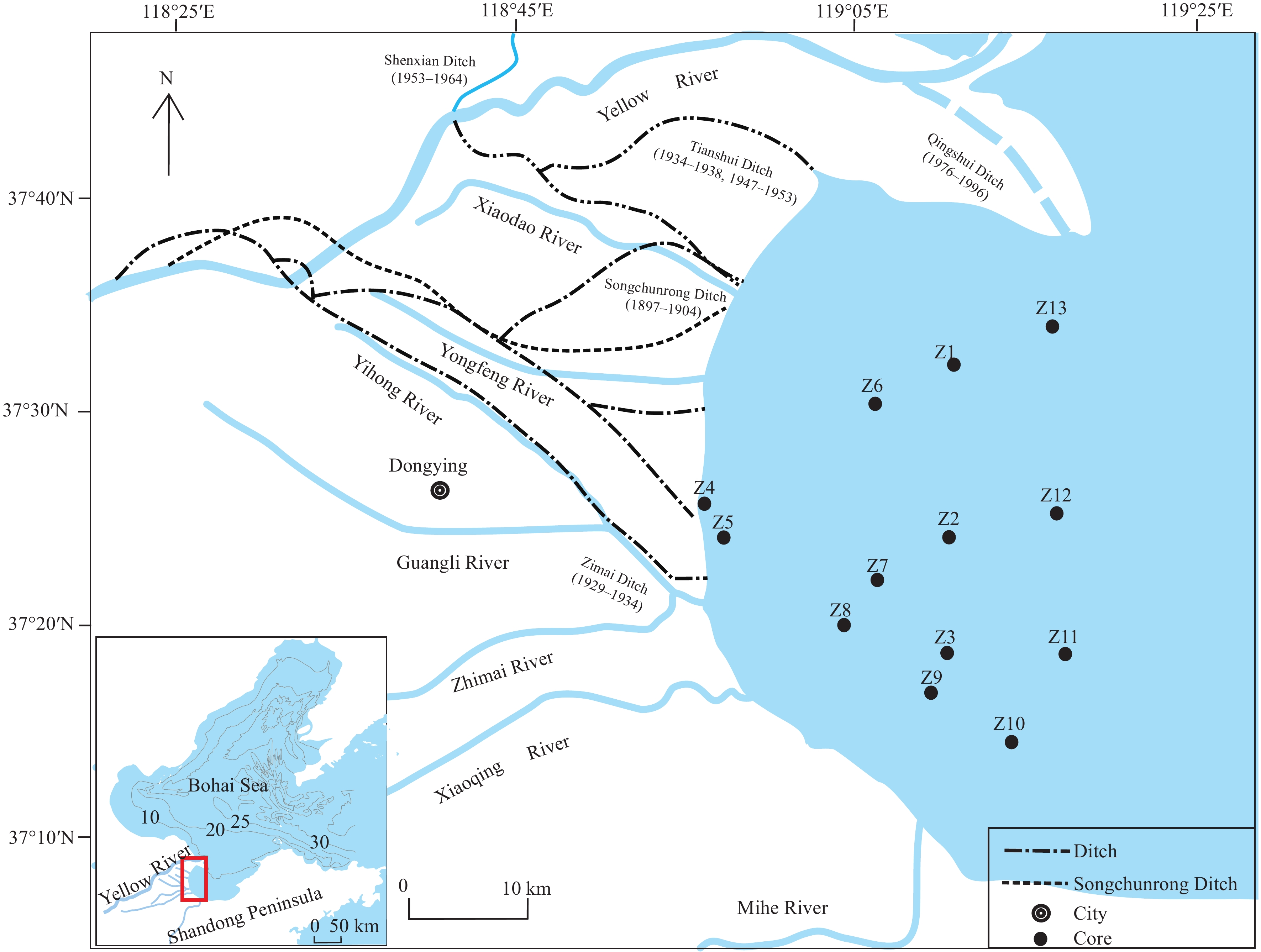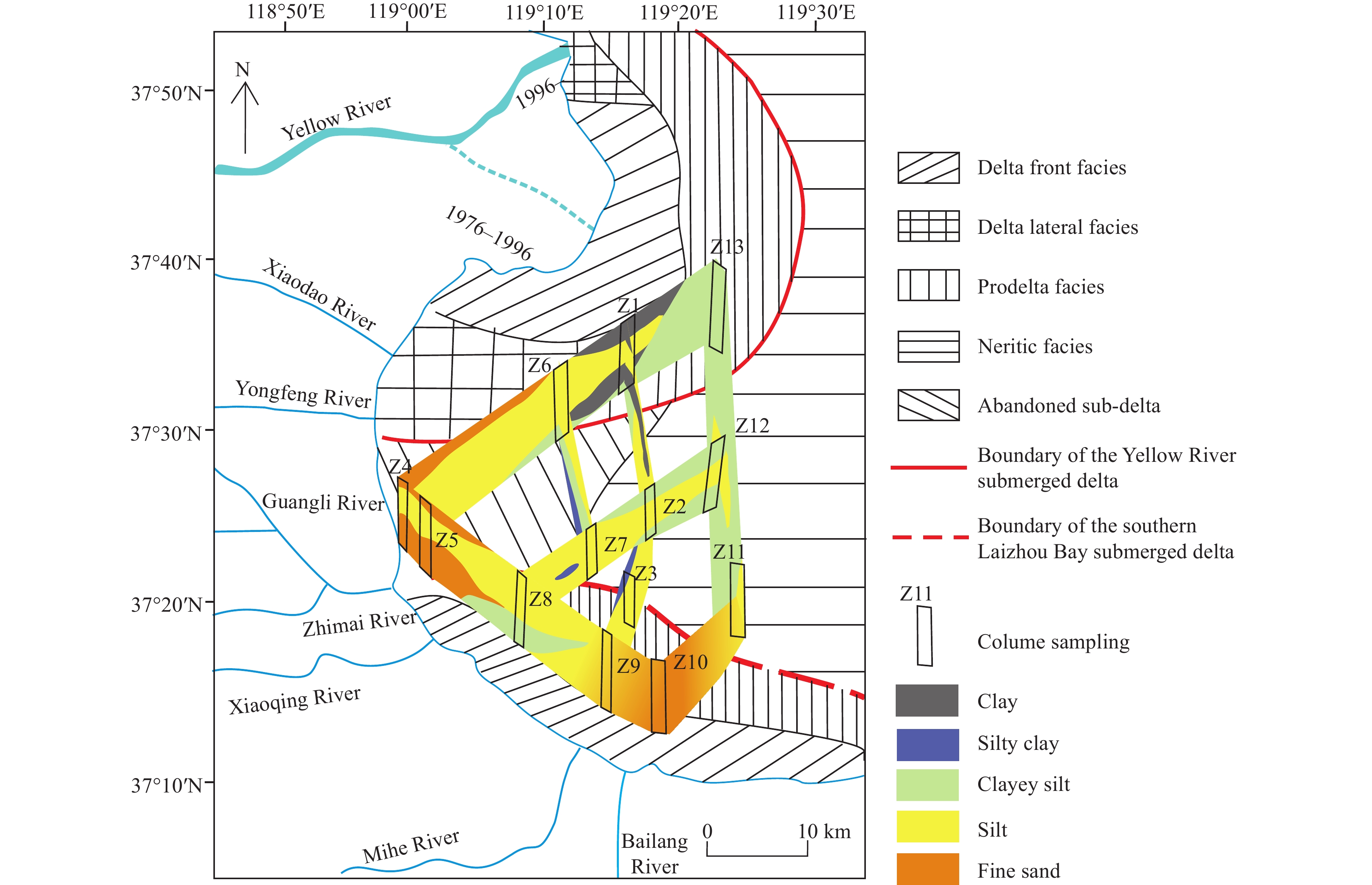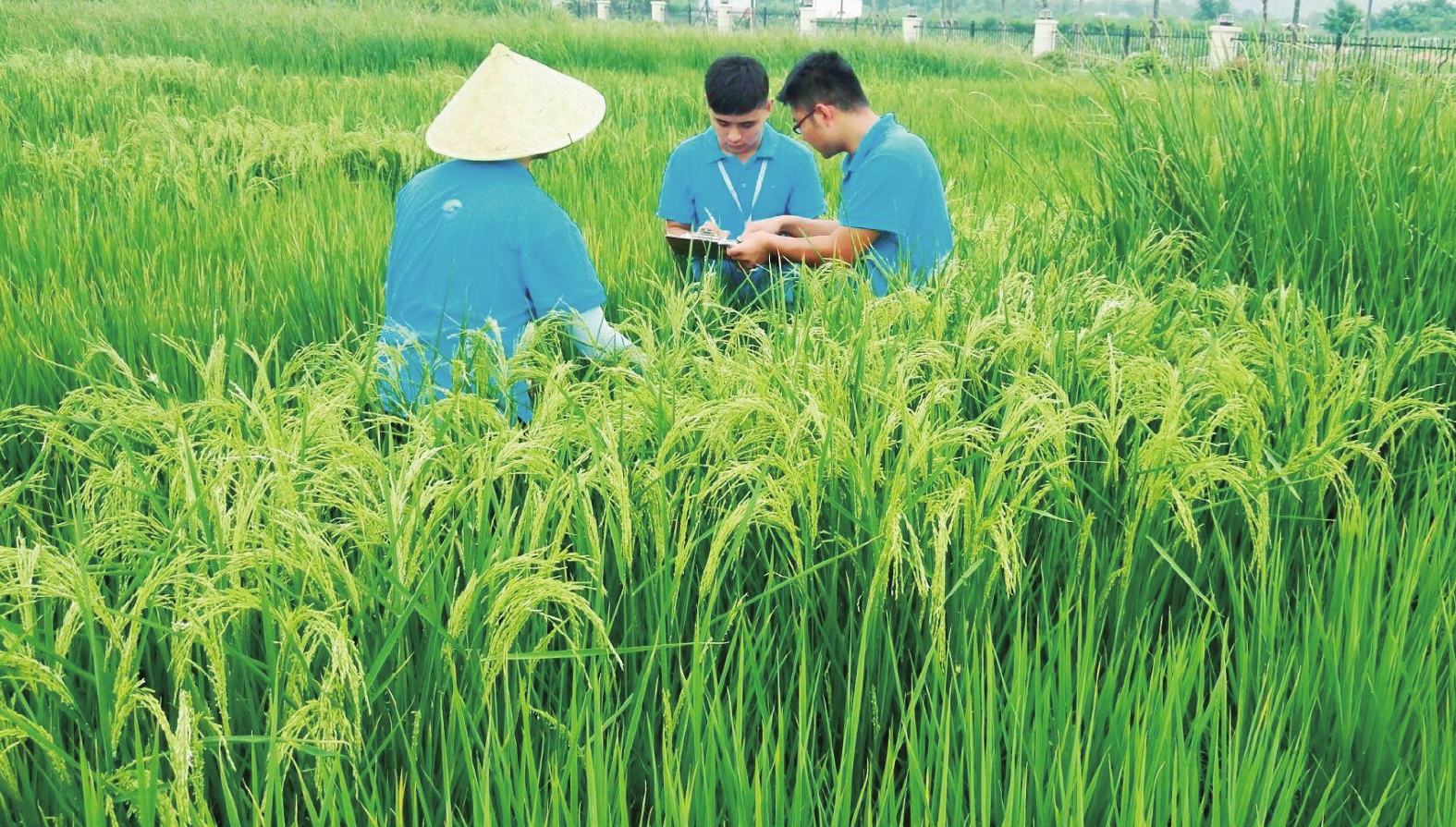| Citation: | Mao-sheng Gao, Guo-hua Hou, Xian-zhang Dang, Xue-yong Huang, 2020. Sediment distribution characteristics and environment evolution within 100 years in western Laizhou Bay, Bohai Sea, China, China Geology, 3, 445-454. doi: 10.31035/cg2020036 |
Sediment distribution characteristics and environment evolution within 100 years in western Laizhou Bay, Bohai Sea, China
-
Abstract
This study is about the reconstruction of fluvial origins based on the grain size distribution of sediment deposits in the western Laizhou Bay, Bohai Sea, China. Thirteen sediment cores were selected to research sediment characteristics using the Sahu discriminant formula, C-M diagram, and Folk method. The results showed: (1) Bounded by the Guangli River estuary, the north sediment was affected by the water and sand flowing from the Yellow River during different periods. The south sediment came from multi-source rivers under the influence of the Xiaoqing River, Mihe River, and other coastal rivers; (2) the deposited sediments were dated by a clear historical record of the branched channel oscillation combined with the characteristics of the diversion channel, erosion, and regression. The subaqueous delta overlapped during several Yellow River channel runs (1897–1904, 1929–1934, 1938–1947, 1947–1953, 1976–1996) and the deposited sediment facies changed (the north tidal flat-abandoned subaqueous delta-lateral delta-delta front); (3) the deposited sediment characteristics can be revealed by studying the branched diversions of the Yellow River and coastal multi-rivers of the past one hundred years.
-
Keywords:
- Sediment /
- Grain size /
- Silt /
- Environment evolution /
- Distribution characteristic /
- Hydrogeological engineering /
- Laizhou Bay /
- Qingdao City /
- China
-

-
References
[1] Bi NS, Wang HJ, Yang ZS. 2014. Recent changes in the erosion-accretion patterns of the active Huanghe (Yellow River) delta lobe caused by human activities. Continental Shelf Research, 90, 70–78. doi: 10.1016/j.csr.2014.02.014 [2] Cheng GD, Ren YC, Li SQ. 1986. Channel evolution and sedimentary sequence of modern Huanghe River delta. Marine Geology and Quaternary Geology, 2, 1–15 (in Chinese with English abstract). doi: 10.16562/j.cnki.0256-1492.1986.02.001 [3] Cheng GD, Xue CT. 1997. The Yellow River Delta Sedimentary Geology. Beijing, Geological Press, 73-83 (in Chinese). [4] Cui BL, Li XY. 2011. Coastline change of the Yellow River estuary and its response to the sediment and runoff (1976–2005). Geomorphology, 127, 32–40. doi: 10.1016/j.geomorph.2010.12.001 [5] Folk RL, Andrews PB, Lewis DW. 1970. Detrital sedimentary rock classification and nomenclature for use in New Zealand. Journal of Geology and Geophysics, 13, 937–968. doi: 10.1080/00288306.1970.10418211 [6] Folk RL, Ward WC. 1957. Brazos River bar: A study in a significance of grain size parameters. Journal of Sedimentary Research, 27, 2–26. doi: 10.1306/74D70646-2B21-11D7-8648000102C1865D [7] Gao MS, Guo F, Huang XY. 2019. Sediment distribution and provenance since Late Pleistocene in Laizhou Bay, Bohai Sea. China Geology, 1, 16–25. doi: 10.31035/cg2018062 [8] Hatten JA, Goñi MA, Wheatcroft RA. 2012. Chemical characteristics of particulate organic matter from a small mountainous river system in Oregon Coast Range, USA. Biogeochemistry, 107, 43–66. doi: 10.1007/s10533-010-9529-z [9] Hsiung KH, Saito Y. 2017. Sediment trapping in deltas of small mountainous rivers of southwestern Taiwan and its influence on East China Sea sedimentation. Quaternary International, 455, 30–44. doi: 10.1016/j.quaint.2017.02.020 [10] Kremer HH. 2004. River catchment-coastal sea interaction and human dimensions. Regional Environmental Change, 4, 1–4. doi: 10.1007/s10113-003-0066-3 [11] Kuehl SA, Nittrouer CA, Allison MA, Faria L, Dukat DA, Jaeger JM, Pacioni TD, Figueiredo AG, Underkoffler EC. 1996. Sediment deposition, accumulation, and seabed dynamics in an energetic fine grained coastal environment. Continent Shelf Research, 16, 787–815. doi: 10.1016/0278-4343(95)00047-X [12] Li J, Hu BQ, Dou YG, Zhao JT, Li GG. 2002. Modern sedimentation rate, budget and supply of the muddy deposits in the east China seas. Geological Review, 58, 745–756 (in Chinese with English abstract). doi: 10.16509/j.georeview.2012.04.010 [13] Li T, Li TJ. 2018. Sediment transport processes in the Pearl River Estuary as revealed by grain-size end-member modeling and sediment trend analysis. Geo-Marine Letters, 38, 167–178. doi: 10.1007/s00367-017-0518-2 [14] Liu JP, David JD, Charles AN. 2017. A seismic study of the Mekong subaqueous delta: Proximal versus distal sediment accumulation. Continental Shelf Research, 147, 197–212. doi: 10.1016/j.csr.2017.07.009 [15] Mcmanus J. 1988. Grain size determination and interpretation. Techniques in Sediment, 3, 33–48. [16] Palinkas CM, Nittrouer CA. 2007. Modern sediment accumulation on the Po shelf, Adriatic Sea. Continent Shelf Research, 27, 489–505. doi: 10.1016/j.csr.2006.11.006 [17] Pan JQ. 2018. Planting the saline-alkali land into smart farmland by sea rice. Rural Agriculture and Farmer, 8, 27–28. [18] Pang JZ, Jiang MX. 2003. On the evolution of the Yellow River estuary. Transactions of Oceanology and Limnology, 4, 1–13 (in Chinese with English abstract). doi: 10.13984/j.cnki.cn37-1141.2003.03.001 [19] Passega R. 1964. Grain size representation by C-M patterns as a geologic tool. Journal of Sedimentary Research, 34, 830–847. doi: 10.1306/74d711a4-2b21-11d7-8648000102c1865d [20] Peng J, Chen SL. 2009. The variation process of water and sediment and its effect on the Yellow River Delta over the six decades. Acta Geographica Sinica, 64(11), 1353–1362 (in Chinese with English abstract). doi: 10.11821/xb200911007 [21] Qiao SQ, Shi XF, Saito Y. 2011. Sedimentary records of natural and artificial Huanghe (Yellow River) channel shifts during the Holocene in the southern Bohai Sea. Continental Shelf Research, 31, 1336–1342. doi: 10.1016/j.csr.2011.05.007 [22] Qin YS, Zhao YY, Zhao SL. 1985. Geology of the Bohai Sea. Beijing, Science Press, 31–49 (in Chinese). [23] Sahu BK. 1964. Depositional mechanisms from the size analysis of clastic sediments. Journal of Sedimentary Petrology, 34, 73–83. doi: 10.1306/74D70FCE-2B21-11D7-8648000102C1865D [24] Saito Y. 2010. Basic patterns of the fine grained sediments on the C-M diagram. Journal of the Sedimentological Society of Japan, 22, 54–64. [25] Wang F, Li JF, Shi PX, Shang ZW, Li Y, Wang H. 2019. The impact of sea-level rise on the coast of Tianjin-Hebei, China. China Geology, 1, 26–39. doi: 10.31035/cg2018061 [26] Wang HJ, Yang ZS, Li GX. 2006. Wave climate model on the abandoned Huanghe (Yellow River) delta lobe and related deltaic erosion. Journal of Coastal Research, 22, 906–918. doi: 10.2112/03-0081.1 [27] Wheatcroft RA, Goni MA, Hatten JA. 2010. The role of effective discharge in the ocean delivery of particulate organic carbon by small, mountainous river systems. Limnology and Oceanography, 55, 161–171. doi: 10.4319/lo.2010.55.1.0161 [28] Xue CF, Jia JJ, Gao S. 2018. The contribution of middle and small rivers to the distal mud of subaqueous Chang Jiang Delta: Results from Jiaojiang River and Oujiang River. Acta Oceanologica Sinica, 40, 75–89 (in Chinese with English abstract). doi: 10.3969/j.issn.0253-4193.2018.05.007 [29] Xue CT, Ding D. 2008. Weihe River-Mihe River delta in south coast of Bohai Sea, China: Sedimentary sequence and architecture. Scientia Geographica Sinica, 5, 672–676 (in Chinese with English abstract). doi: 10.13249/j.cnki.sgs.2008.05.005 [30] Xue CT, Ye SY, Gao MS. 2009. Determination of depositional age in the Huanghe Delta in China. Acta Oceanologica Sinica, 31, 117–124 (in Chinese with English abstract). doi: 10.3321/j.issn:0253-4193.2009.01.015 [31] Yang HR, Wang J. 1990. Quaternary transgressions and coastline changes in Huanghe River delta. Marine Geology and Quaternary Geology, 3, 1–14 (in Chinese with English abstract). doi: 10.16562/j.cnki.0256-1492.1990.03.001 [32] Yang RM, Li GX, Li AL. 2005. Studies on sedimentary characteristics and process of erosion-accumulation of Guangli River mouth bar. Periodical of Ocean University of China, 35, 339–343 (in Chinese with English abstract). doi: 10.16441/j.cnki.hdxb.2005.02.034 [33] Ye QH, Chen SL, Huang C. 2007. Characteristics of landscape information Tupu of the Yellow River swings and its subdeltas during 1855–2000. Science in China Series D: Earth Sciences, 50, 1566–1577. doi: 10.1007/s11430-007-0056-2 [34] Yin P, Duan XY, Gao F, Li MN, Lü SH, Qiu JD, Zhou LY. 2018. Coastal erosion in Shandong of China: Status and protection challenges. China Geology, 1, 512–521. doi: 10.31035/cg2018073 [35] Yu Z, Wu S, Zou D, Feng D, Zhao H. 2008. Seismic profiles across the middle Tan-Lu fault zone in Laizhou Bay, Bohai Sea, Eastern China. Journal of Asian Earth Science, 33, 383–394. doi: 10.1016/j.jseaes.2008.03.004 [36] Zhang J. 2011. On the critical issues of land-ocean interactions in the coastal zones. Chinese Science Bulletin, 56, 1956–1966 (in Chinese with English abstract). doi: 10.1360/972011-465 [37] Zhou LY, Liu JP, Saito Y. 2016. Modern sediment characteristics and accumulation rates from the delta front to prodelta of the Yellow River (Huanghe). Geo-Marine Letters, 36, 247–258. doi: 10.1007/s00367-016-0442-x -
Access History

-
Figure 1.
The location of research area and 13 core sites in western of the Laizhou Bay.
-
Figure 2.
Triangular diagram of sand-silt-clay in column samplings.
-
Figure 3.
Vertical grain size distribution and the main parameters in 13 cores.
-
Figure 4.
Vertical distribution of the parameter discriminant value in eight cores.
-
Figure 5.
The C-M diagrams of sedimentary column sampling in western Laizhou Bay. Eight sedimentary segments (Ⅰ–Ⅷ) and five sedimentary graph sections (NO, OP, PQ, QR and RS) by C and M. RS–homogenous suspension; QR–graded suspension; PQ–dominated by suspended deposition; OP–mainly rolling transportion mixed with suspension; NO–rolling transportion.
-
Figure 6.
The fence diagrams and sedimentary facies model in Western Laizhou Bay, China (Modified from Cheng GD and Xue CT, 1997; Xue CT and Ding D, 2008).
-
Figure 7.
Vertical distribution of the grain size and cumulative relative curve in the shallow sea.
-
Figure 8.
Diversions of the Yellow River and sedimentary area of coastal rivers within 100 years. a–the Yellow River diversion at Guangli estuary (1897–1904 and 1929–1934); b–the Yellow River diverted to north in three strands (1934–1938 and 1947–1953), and a new sediment area forming (Guangli River as a separate distributary); c–the Yellow River flowed to Qingshui Ditch, and the sediment area spread (1976–1996).
-
Figure 9.
Sea rice of saline-alkali soil in Shandong coastal (after Pan JQ, 2018).





 DownLoad:
DownLoad:







